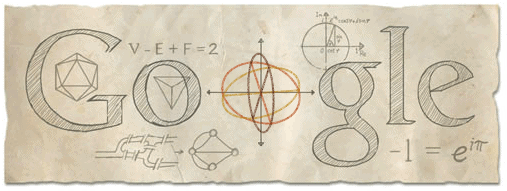Google has a new doodle out today (the 15th of April) to celebrate the 306th birth anniversary of Leonhard Euler, the Swiss mathematician and physicist. This prompted some reflection on his work (and some mathematical poetry)…

At the bottom right of the doodle above you can see an equation, famously called Euler’s identity. It is usually represented as follows:
![]()
It is famous because it combines into one simple equation the following elements:
- The number 0, the additive identity
- The number 1, the multiplicative identity
- The number pi, the ration of a circle’s circumference to its diameter
- The number e, the base of the natural logarithms
- The number i, the imaginary number that equals the square root of -1
Moreover, these constants are joined together by three basic arithmetic operations (addition, multiplication and exponentiation), each of which appears just once!
Can you pack more into one equation! It is no wonder that this equation has often been called the “gold standard for mathematical beauty!”
Anyway, Euler’s identity has appeared on this blog a couple of years ago – most specifically in a mathematical poem (titled The Imaginary i). Euler himself has appeared in these poems a couple of times as well. If you haven’t read these poems before, here they are again, in celebration of Euler’s birthday. Enjoy…
- Goldbach’s Conjecture: In which Goldbach makes a conjecture in a letter to Euler
- Goldbach’s Variations: A followup to the previous poem that explores why Goldbach got the credit for the conjecture that was actually made by Euler
- The mathematical “i”: An attempt to understand the value of the imaginary in mathematics (and in life)

0 Comments